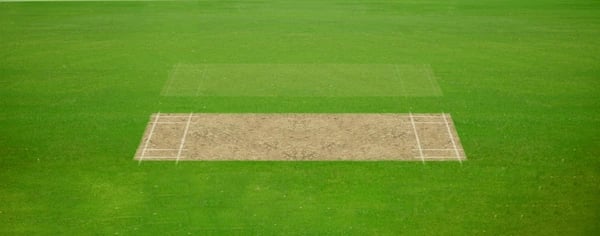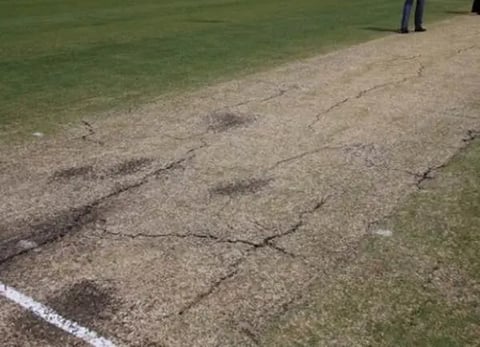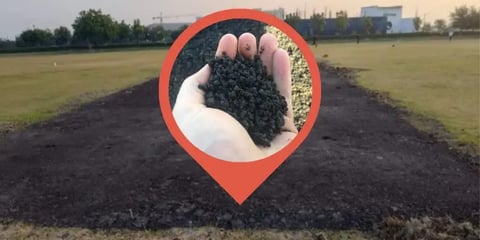Pitch Perfect
The Art and Science Behind Cricket Surfaces
LATESTSPORTS
Arjun Prabhakar
4/17/20254 min read


The cricket pitch, the central stage for the battle between bat and ball, is a carefully crafted surface whose characteristics significantly influence the game's trajectory. Its creation is a blend of horticultural science, meticulous preparation, and an understanding of how different soil types behave under varying conditions. Assessing these conditions is an equally crucial skill for players and captains, informing their strategies and decisions.
The Foundation: Soil Types and Their Behavior
The heart of a good cricket pitch lies in the soil used for its construction. The ideal soil composition aims for a balance that allows for firmness, even bounce, and gradual wear to assist both batsmen and bowlers at different stages of a match. The primary soil types employed in cricket pitch construction are broadly categorized based on their clay content:
● Clay Soils (Black Soils): These soils have a high clay content (often exceeding 50%), giving them excellent binding properties and water retention capacity.
Behavior: Pitches made with black soil tend to be slower initially but can become good batting surfaces as they settle. They offer lower bounce compared to red soil and tend to wear more slowly, potentially aiding spinners later in the game as cracks develop. Their elasticity can also lead to variable bounce on worn pitches.
● Loam Soils (Red Soils and Mixtures): Loam is a mixture of sand, silt, and clay. Red soils typically have a lower clay content than black soils and often include a significant proportion of fine sand and silt. Curators often blend different soils to achieve specific characteristics.
Behavior: Red soil pitches generally offer more bounce and pace early on due to their firm nature and better drainage. They tend to dry out and crumble faster than black soil pitches, often assisting spin bowlers earlier in the match. Mixtures of loam are used to tailor the pitch's pace, bounce, and durability. For instance, adding yellow soil can increase the clay content in red soil.
The behavior of these soils is further influenced by factors like moisture content, compaction, and the presence of organic matter. Moisture makes the soil softer, potentially leading to slower ball speeds and aiding seam and swing bowlers. Proper compaction ensures firmness and even bounce.


Crafting the Canvas: The Creation Process
Creating a quality cricket pitch is a multi-stage process that demands precision and timing:
Selection and Preparation of the Square: The rectangular area designated for pitches (the square) is carefully chosen, ideally with a slight north-south orientation to ensure even drying. Topsoil is often excavated to a specific depth.
Drainage Layer (Optional): For new constructions, a gravel layer might be laid to improve drainage, especially in areas prone to wet conditions.
Binding Layer (Optional): A layer of coarser material might be added above the gravel to provide stability.
Loam Application: The chosen cricket loam, a specific blend of clay, silt, and sand, is applied in layers, typically to a depth of 60-90mm. Each layer is consolidated to prevent uneven settling.
Leveling and Tracking: The loam surface is meticulously leveled and tracked to create a smooth and even playing surface. Laser-guided machinery is often used for accuracy.
Seeding and Fertilizing: The square is seeded with appropriate grass varieties, and fertilizers are applied to promote healthy growth and a dense surface.
Pre-Season Rolling: Crucial for achieving pace and even bounce, the square is rolled over several weeks, starting with a light roller and gradually increasing the weight to consolidate the soil to a depth of around 100mm. Cross-rolling is emphasized in the early stages.
Regular Maintenance: Throughout the season, pitches are mowed to a specific height (typically reducing to 6-12mm before a match), brushed to stand the grass, and lightly rolled as needed. Watering is carefully managed to maintain optimal moisture levels.
Match Preparation (10-14 days prior): The specific pitch for a match undergoes intensive preparation, including brushing, mowing, raking/scarifying (lightly), irrigation, and rolling.The aim is a dry, firm, and true surface.
Marking: Creases are marked accurately before the match.


Reading the Game Beneath Your Feet: Assessing Pitch Conditions
Understanding the likely behavior of a pitch before and during a match is vital for strategic decision-making. Captains, bowlers, and batsmen all need to "read" the pitch. Key factors to assess include:
● Visual Inspection:
Grass Cover: A green, grassy pitch suggests moisture and potential for seam and swing movement, favoring fast bowlers initially.Less grass indicates a drier surface that might assist spinners later. Bare patches could lead to uneven bounce.
Color: A brown or dusty pitch typically indicates dryness, which can favor spin as the match progresses. A darker color might suggest retained moisture.
Cracks: Existing cracks, especially on a dry pitch, are a sign that the surface will likely break up, offering turn for spinners and potentially uneven bounce for batsmen.
Hardness: Pressing a fingernail or foot into the surface can give an indication of hardness. A harder pitch generally offers more pace and bounce.
● Moisture Levels: Observe for dew, damp spots, or how quickly the surface dries after watering or rain. Moisture affects the pace and movement of the ball.
● Bounce and Pace: Observing warm-up deliveries or even bouncing a ball on the pitch can provide insights into the expected bounce and pace. Low bounce can make batting challenging, while high bounce requires adjustments in shot selection.
● Past Records: Analyzing the history of the pitch, including average scores and the types of bowlers who have been successful, can offer valuable clues.
● Weather Conditions: Humidity can aid swing bowling, while heat can dry out the pitch, assisting spin. Rain can make the pitch soft and unpredictable initially.
● Rolling: The amount and type of rolling done before the match can influence the pitch's firmness and pace. A heavily rolled pitch is likely to be flatter and favor batsmen initially.
By carefully considering these factors, players and captains can develop strategies to exploit the pitch conditions and gain a crucial advantage in the game. The cricket pitch is far more than just a strip of ground; it is a dynamic entity that dictates the ebb and flow of the contest, demanding both skillful creation and astute interpretation.
